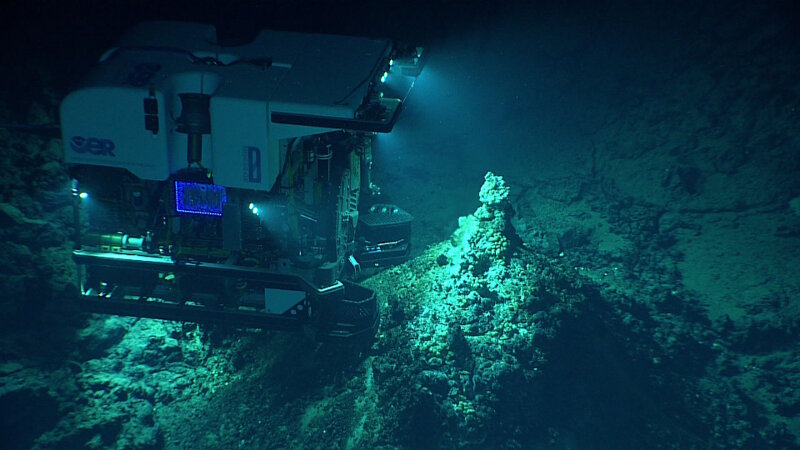
ROV Deep Discoverer images a newly discovered hydrothermal vent field at Chammoro Seamount. Image courtesy of the NOAA Office of Ocean Exploration and Research, 2016 Deepwater Exploration of the Marianas. Download larger version (jpg, 717 KB).

ROV Deep Discoverer images a newly discovered hydrothermal vent field at Chammoro Seamount. Image courtesy of the NOAA Office of Ocean Exploration and Research, 2016 Deepwater Exploration of the Marianas. Download larger version (jpg, 717 KB).
Chamorro Vent Discovery
Hydrothermal vents are most commonly found near areas that are volcanically or tectonically active. So when scientists set out to explore Chamorro Seamount, which had no known historic eruptions, they weren't expecting to find vent communities...but they did. Seen at a depth of ~980 meters (3,215 feet), the hydrothermal vents on the outer southeast slope of the seamount's summit crater were indeed an unexpected, and exciting, discovery.
Hydrothermal vents occur when super-heated water comes out of a fissure of Earth's surface. The geothermally heated water inside the chimney can reach temperatures of several hundred degrees Celsius, while the water surrounding the vent is about two degrees Celsius in the deep sea. As soon as the hot fluid comes in contact with ambient sea water, it drastically drops in temperature and hydrothermal mixing occurs.
The hot fluids at vents contain minerals such as hydrogen sulfide that provide food for bacteria through a process known as chemosynthesis. Chemosynthetic bacteria are at the heart of deep-sea communities, sustaining life in absolute darkness, where sunlight does not penetrate.
The chimney mounds at Chammoro were small (one to two meters high), but a temperature measurement taken at one chimney was as high as 31.14°C. The dominant fauna throughout the dive was stylasterid corals (a type of hydrocoral) and animals known to be found in common association with vents, such as the Alvinoconcha snails and alvinocaridid shrimp seen in the video. Other fauna documented during the dive included unusual amphipods, rare blind (polychelid) lobsters, two species of unidentified demosponges, cutthroat eels and rattails, and a variety of fish swimming near the vents. Video courtesy of the NOAA Office of Ocean Exploration and Research, 2016 Deepwater Exploration of the Marianas. Download (mp4, 101.2 MB)
Dive 7 was conducted at the outer southeast slope of the summit crater on Chamorro Seamount. Starting from a depth of 980 meters, remotely operated vehicle Deep Discoverer (D2) traversed a fragmented seafloor composed of volcanic ash, cobbles, and boulders. The first discovery of hydrothermal activity was a vent from a small chimney structure producing 10.5°C fluid. After a descent into the crater, D2 documented additional hydrothermal activity across a previously unknown vent field. The chimney mounds were small (one to two meters high), but a temperature measurement taken at one was as high as 31.14°C. The dominant fauna throughout the dive was stylasterid corals – a type of hydrocoral, and animals known to be found in common association with vents, like Alvinoconcha snails, alvinocaridid shrimp, and vent crabs. Other fauna documented included unusual amphipods, rare blind (polychelid) lobsters, two species of unidentified demosponges, cutthroat eels and rattails, and a variety of fish swimming near the vents. Overnight mapping operations were conducted at Daikoku and Eifuku Seamounts and revealed an exciting discovery of a strong acoustic signal in the water column over Daikoku Seamount, believed to be a hydrothermal plume.